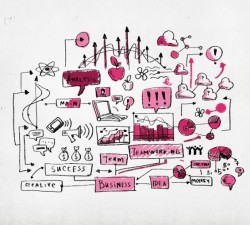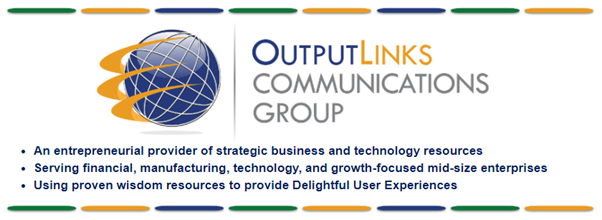
By Jacob Aizikowitz
C-Level Advisor, the OutputLinks Communications Group
Enterprises Often Overlook Print Media as They Plan Their Omnichannel
 I decided to write this note because I am intrigued by what I see as a big gap between the print industry's praising of print's value and the reality of print's infrequent use by enterprises' marketing. Assuming my observation is correct, one must wonder why enterprises often overlook print in their Customer Experience efforts. Why is it that enterprises tend to focus purely on digital media for their customer experience efforts?
I decided to write this note because I am intrigued by what I see as a big gap between the print industry's praising of print's value and the reality of print's infrequent use by enterprises' marketing. Assuming my observation is correct, one must wonder why enterprises often overlook print in their Customer Experience efforts. Why is it that enterprises tend to focus purely on digital media for their customer experience efforts?
Many in the print industry believe that this declining use of print is due to a lack of awareness of print's value in the media mix of Omnichannel marketing. While I agree with the importance of awareness, I think that a lack of awareness is not the issue here. There is a vast and growing body of research that repeatedly proves the unique value of print, and we cannot assume that enterprises are ignorant of this work. Hence, in my view, lack of awareness cannot be the main reason for the infrequent use of print in enterprises' customer experiences efforts.
I suggest that the main causal for print's infrequent use in modern Enterprise marketing is a technology gap, which is all-around how one uses data and rules -- for personalization or customization -- in print and digital media. I believe that this gap leads enterprise marketing professionals to perceive print as foreign, cumbersome, not timely, and costly. Furthermore, I think that such perceptions "kill" the use of print, even for executives who are fully aware of print's unique positive values.
Let's zoom-in and understand better the gap and its impact.
It Is All About Online vs. Offline Handling of Data and Rules
Every personalization technology must interact with data and use rules (also known as "logic" or "code") to determine the individualized content and appearance of touchpoints – e.g., email, website, direct mail, etc. -- that make each person's journey and experience.
In the digital media world, such technologies use data and rules in an online fashion. For example, websites interact directly with databases and use computations on such data (e.g., by having scripts as part of the website "code") to present the visitor with individualized content or update the data to reflect the visitor's interaction. And it is all done live, as part of the visitor's interactions with the media. One of the benefits of using data and rules in a live and online nature is that the customer experience is always current. Being current means that it will reflect not only what was known about the person from their history or demographics, but, for every touchpoint, it will reflect changes and choices made, by the person, in previous touchpoints of their current journey!
 The print world uses data and rules differently. For reasons rooted in the early days of digital printing, the software creators for variable data printing, such as in forms or transactional documents, developed a two-phase approach for handling data and rules. The first phase was processing the input data and applying the rules to create a simple representation of the data needed for the job at hand. The second phase processed this "simplified" data (and the document template) to emit instructions to the print engine at a speed that matched or exceeded the printing speed.
The print world uses data and rules differently. For reasons rooted in the early days of digital printing, the software creators for variable data printing, such as in forms or transactional documents, developed a two-phase approach for handling data and rules. The first phase was processing the input data and applying the rules to create a simple representation of the data needed for the job at hand. The second phase processed this "simplified" data (and the document template) to emit instructions to the print engine at a speed that matched or exceeded the printing speed.
While the second phase was real-time in nature, having to feed the print engine while the engine was already printing the job, the first phase was offline. It was all about processing the complex input data and rules, transforming them into a simple data representation – almost always some form of one table with rows representing recipients and columns all relevant data needed for the job at hand. This process could take as much time as required, and it took place hours or weeks before launching the second phase, and in many cases, not even at the same facility where the second phase and the print took place.
 Matt Swain Podcast: Dr. Jacob Aizikowitz, an OutputLinks Communications Group Senior Strategic Consultant and an XMPie Founding Partner, discusses cross-channel personalization, segmentation, and integrated journeys. "Doing something that is engaging, creative, highly personal, and highly relevant takes work. So there must be a significant return -- and there is."
Matt Swain Podcast: Dr. Jacob Aizikowitz, an OutputLinks Communications Group Senior Strategic Consultant and an XMPie Founding Partner, discusses cross-channel personalization, segmentation, and integrated journeys. "Doing something that is engaging, creative, highly personal, and highly relevant takes work. So there must be a significant return -- and there is."
Many of the leading print personalization solutions continue embracing the two-phase process from above; hence, they are offline. Most importantly, for as long as print has this offline nature, it is impossible to integrate it into customer experiences and guarantee, for every print touchpoint, that it will reflect the person's interactions that preceded the print touchpoint in the current journey.
This note's thesis is that this offline vs. online difference between the technology and workflows serving print-media and digital-media for data-driven applications shapes how marketing executives perceive print. I suggest that for the print industry to be relevant in this digital age, the data and rules technologies for print media must become online, precisely like those supporting digital media. Without that, enterprises will either drop print altogether or use it in an overly simplistic fashion, which will not deliver the value that the research supporting print promotes.
Looking Ahead
Is it possible for print to become online, pretty much like digital? Given today's computing  technologies – CPU speed, memory size, communications-bandwidth, Cloud, parallel processing, caching, and distributed processing – the answer should be yes. In thinking about breaking away from this legacy two-phase concept, we must remember that requiring print to satisfy real-time requirements is not unique. Digital has an ever-evolving and demanding need to be relevant to the individual and be current in a timely and responsive fashion; a digital touchpoint must reflect a person's interaction immediately in either a previous step or touchpoint of the person's journey. And yet, the solutions for digital media never took the path of trading relevancy for responsiveness; instead, they embrace all computing and networking advances to be Relevant and Timely, always!
technologies – CPU speed, memory size, communications-bandwidth, Cloud, parallel processing, caching, and distributed processing – the answer should be yes. In thinking about breaking away from this legacy two-phase concept, we must remember that requiring print to satisfy real-time requirements is not unique. Digital has an ever-evolving and demanding need to be relevant to the individual and be current in a timely and responsive fashion; a digital touchpoint must reflect a person's interaction immediately in either a previous step or touchpoint of the person's journey. And yet, the solutions for digital media never took the path of trading relevancy for responsiveness; instead, they embrace all computing and networking advances to be Relevant and Timely, always!
Your Opinion?
I would love to hear your opinions on print’s relationship to digital media. You can post them in the comments section below or email me at [email protected].
In closing
In closing, let me add that I did not address the influence of such technology gaps on applications where print is a must. A current and fast-evolving category of such applications is Labels and Packaging. For such applications, print is a must. Still, print's software and workflow technologies should enable printed objects (e.g., a package) to be just one touchpoint in a customer journey, which may transcend media types and time. Brand executives highly desire such experiences. Hence enabling print as an equal citizen with all digital media is what brands desire, even if they are not explicitly specifying it.



Prefer to comment without registration? Click in the Name field and select "I'd rather post as a guest"